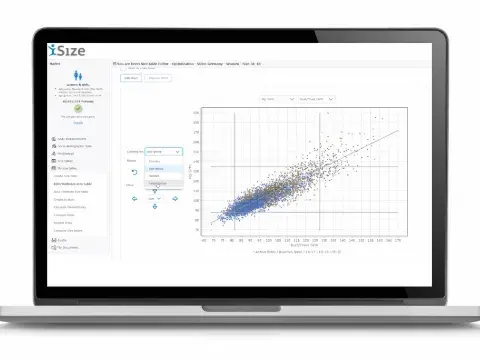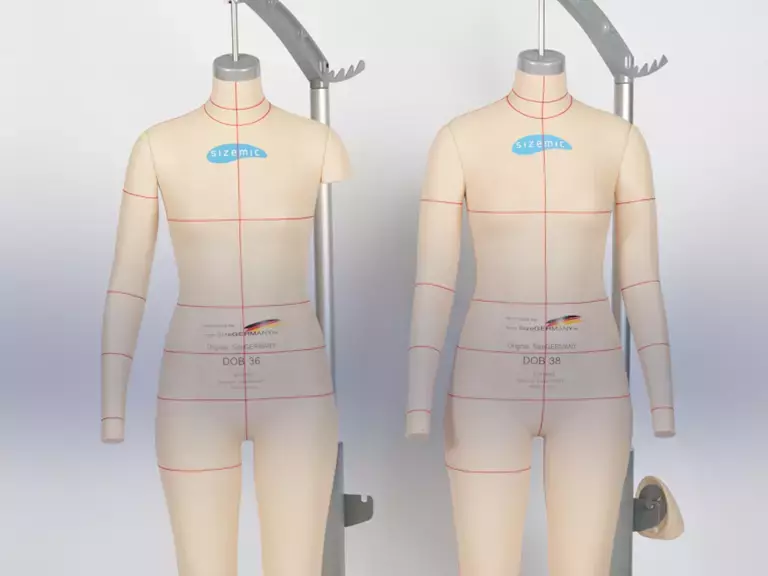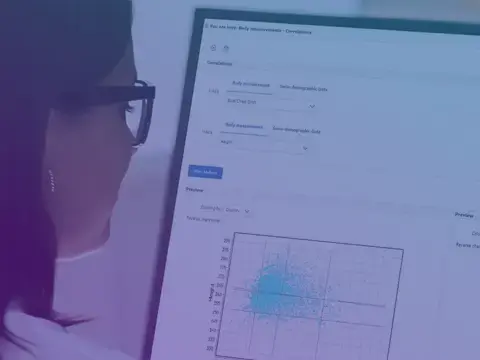Time to design is shorter than ever.
Design and engineering teams across industries are facing growing pressure to deliver faster, more personalized products. In the apparel and workwear sectors, especially, the consequences of poor fit can be serious. Missed sizing targets can lead to high return rates, product failure, or even safety risks.
To solve this, leading brands are adopting body data and digital development tools that shorten timelines and improve user satisfaction. Humanetics supports this shift with iSize, a powerful anthropometric database that turns real human measurements into usable design tools for digital and physical product development.
Accurate Body Data for Faster, Smarter Design
At the core of the Humanetics solution is real-world data. Using 3D body scans collected from people across global populations, iSize provides statistically accurate measurements across age, gender, body type, and region. These measurements reflect the diversity of actual users, not just theoretical averages or outdated standards.
But raw scan data alone is not enough. Humanetics processes this data and transforms it into actionable tools for product teams that need accuracy, efficiency, and reliability in every phase of development.
A web platform to optimize size charts and improve sizing strategy. It allows designers to visualize how real users fit into sizing ranges and identify where gaps or inconsistencies may occur.
Virtual human models with realistic motion, used to simulate garments, test mobility, and support digital approvals. These avatars are especially valuable for early-stage design, allowing teams to make faster, data-informed decisions before committing to physical production.
Physical mannequins modeled after specific body types or percentile groups, used for fittings and quality reviews. These are crucial for the physical validation of sample garments and ensuring consistent quality control across distributed teams.
These outputs are built directly from iSize’s statistical models. Every tool reflects the real dimensions of real people, helping product teams avoid guesswork and move from concept to approval with greater speed and confidence.
When brands design with precise, validated data, they can tailor products to specific user groups, improve garment performance, and increase customer satisfaction. The result is a streamlined development process that anticipates user needs, rather than reacting to fit issues late in the cycle.
Solving the Disconnect Between Digital Design and Physical Fit
A common challenge in apparel development is the gap between what’s created in software and what actually works in the real world. Garments that look correct in software may not behave the same way when manufactured or worn. Differences in material behavior, construction techniques, or body interaction can all result in a poor fit if digital assumptions don’t match physical reality.
Humanetics addresses this by ensuring digital avatars and physical fit forms come from the same data source. This shared foundation provides:
- Consistent sizing references across design and manufacturing teams
- Physical samples that align with digital intent
- Greater transparency when working with external vendors and suppliers

By using the same core data across both virtual and physical tools, Humanetics creates a unified system. Teams avoid conflicting fit results or misaligned sample reviews, which are common when digital prototypes don’t match physical expectations.
Fewer miscommunications mean fewer revisions and less waste. Brands can reduce material errors, avoid overproduction, and more easily meet sustainability goals. This not only improves development efficiency but also helps companies achieve broader Environmental, Social, Governance (ESG) targets through the smarter use of resources.
For large global teams, shared avatars and fit forms also standardize product development. A prototype built in Asia can be reviewed and approved with confidence by teams in Europe or North America, because everyone is working from the same baseline. This creates consistency across product lines and eliminates the trial-and-error that often delays launch schedules.
By aligning virtual tools with physical validation, teams can eliminate surprises during production and accelerate go-to-market timelines. This clarity between teams, regions, and vendors builds trust and improves performance across the supply chain.
Supporting Performance and Safety in Workwear Design
Workwear needs to do more than fit. It must support movement, perform in high-stress environments, and meet functional and regulatory standards. Whether in the military, healthcare, transportation, or public safety, workwear must be a reliable tool for demanding jobs.
Humanetics avatars allow workwear developers to:
- Simulate real-life movements such as reaching, kneeling, or twisting
- Test mobility and fit across different body types
- Evaluate fit scenarios before making physical samples
- Identify pressure points or stress zones through movement testing
Avatars created from iSize data allow teams to visualize performance across a spectrum of users and scenarios. Designers can explore how garments behave under real-world conditions, how they move with the body, where they stretch or bind, and how they accommodate gear or accessories.
For mission-critical use, a poor fit can affect safety and performance. Clothing that restricts motion or does not accommodate protective gear can create operational risks. Avatars give design teams better insight, allowing them to prevent issues early in the development cycle.
These digital environments also support rapid iteration. Design teams can explore alternatives quickly while balancing needs for durability, comfort, and compliance. For programs with tight timelines or contract deadlines, this speed is a significant advantage.
Workwear developers can also fine-tune designs for specific regions or job roles without sacrificing consistency. This flexibility is especially valuable in procurement environments where different branches or job functions have unique requirements but still need to fall under a unified brand or fit strategy.
Physical Fit Forms for Final Validation
While avatars help speed up development, physical fit forms are still essential for final checks. Humanetics provides both standardized and custom forms based on actual body data rather than abstract size charts. These forms support:
- Quality control with manufacturers
- Consistent sample reviews across regions
- Standardized fit across product lines and launch phases
Fit forms are particularly useful in distributed production models. When multiple vendors are involved, they help maintain workwear fit standards regardless of geography.
These physical forms are based on the same data as Humanetics avatars, which ensures alignment from digital concept through physical execution. Fit forms also make it easier to test how multiple garment layers interact, something that is harder to assess in virtual environments.

Garments may fit well in isolation but behave differently when layered, worn in motion, or paired with accessories. Fit forms allow teams to test real use cases—whether that means checking how a jacket fits over body armor or how medical scrubs accommodate equipment belts.
In large-scale programs like government contracts or airline uniforms, physical fit forms help avoid costly errors and ensure products meet specifications before production begins. They also play a role in audits, compliance reviews, and vendor evaluations, providing measurable benchmarks for garment quality and consistency.
Humanetics also creates specialty forms to meet unique requirements. This includes seated posture forms for transportation sectors and body models that represent underserved or plus-size populations. These inclusive forms support broader product reach and ensure comfort, safety, and performance across all user types.
Interested in Content Like This?
Subscribe to the Humanetics Pulse newsletter to learn more about Humanetics Digital.
Expert Services to Turn Data into Design Assets
Not every team has the internal expertise to analyze body data or manage complex sizing challenges. Humanetics offers support services that help turn human measurement data into design-ready solutions.
These services include:
- Identifying the right population for your product and market
- Filtering and analyzing anthropometric data
- Building avatars for use in 3D and CAD systems
- Provide consulting concerning sample size definition and fit model selection
- Manufacturing and supplying custom physical fit forms
- Provide training and support for the implementation of all services in product development teams
This support benefits industries like aerospace, defense, and industrial safety, where the fit of protective gear, such as helmets, body armor, and harnesses, can directly affect performance and safety.
Humanetics’ engineering team helps clients move beyond raw data to design assets that integrate seamlessly into existing workflows. The ability to create and iterate with confidence reduces internal workload, accelerates approvals, and supports alignment across disciplines.
Whether you are developing inclusive sportswear, adaptive clothing, or occupational workwear, Humanetics provides the tools and expertise to streamline your workflow and reduce internal development effort.
Grounding Innovation in Real Human Data
The shift toward digital design is only valuable if it connects to physical reality. The strength of iSize is not just its data volume, it is the ability to turn that data into consistent, reliable tools for design and validation.
With digital avatars for simulation and fit forms for physical checks, Humanetics bridges the gap between virtual design and real-world use. Brands can improve fit accuracy, reduce development time, and better serve today’s diverse and global customer base.
From digital fittings to sample room reviews, the Humanetics ecosystem keeps every product grounded in real human measurements. This brings speed, confidence, and inclusivity to modern apparel development.
By building your product strategy on verified body data, you can create designs that are not only faster to develop, but also built to perform, meeting the needs of real people in real environments with precision and consistency.
Speak to an Expert
Fill out the below form and one of our experts will contact you.

Anke Rissiek
Anke is the Global Product Manager and Business Development Lead at Humanetics for Body Data, with over 30 years of experience in sizing strategy and fit development. She specializes in translating measurement data into size tables, 3D avatars, and fit forms, helping brands create target group-specific sizing concepts that drive business success. Anke also serves on the International Association of Clothing Designers & Executives, working with industry leaders worldwide on sizing trends and standards.







